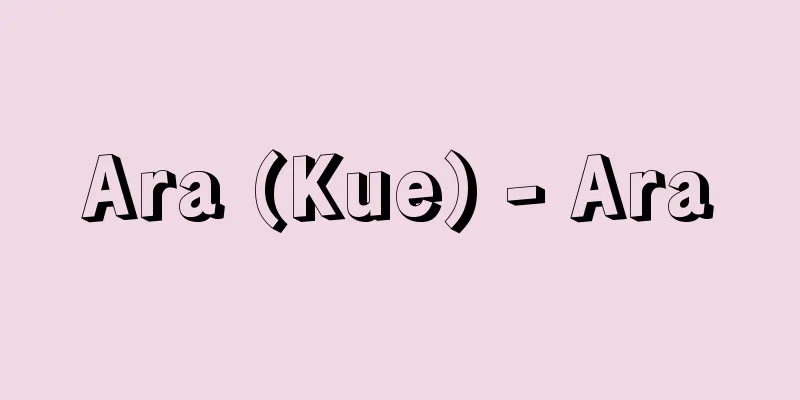Fisheries resources

|
Organisms that live in the ocean or inland waters (rivers, lakes, and marshes) are called aquatic organisms, and among them, those that humans use for food or other purposes are considered fishery resources. In other words, it refers to a group of aquatic organisms that are the subject of the fishing industry or that are intended for future use. Aquatic organisms themselves cannot be considered fishery resources; it is important that humans have the methods and technology to capture and use them as needed. Even if there are a huge number of organisms in the water, if there is no technology to capture and use them, those organisms cannot be considered fishery resources. [Kiyoshi Yoshiwara] Characteristics of fishery resourcesFisheries resources, which are organisms that live in water, have several characteristics that distinguish them from other natural resources. The first characteristic is autonomous renewal. The amount of resources that exist at a given moment is depleted by the death of individuals that make up the resource, but parents give birth to offspring to increase the number of individuals (reproduction), and individuals grow and increase in mass, resulting in biological production, and each resource is autonomous (self-regulating) in that it is constantly renewed at its own turnover rate. In virgin resources where fishing is not carried out, the change in resource amount is in equilibrium between the recruitment + increase in mass, which is the factor of increase, and the amount of natural death, which is the factor of decrease. However, when fishing is added, the resource decreases by the amount of the catch, but a restoring force acts on the resource, and a new equilibrium state different from that in the case of virgin resources is created. If only this restoring force is caught every year, the resource can be used permanently without changing the resource level. This quantitative level is called the sustainable production. However, if fishing pressure is applied beyond this restoring force, the resource will gradually decrease and become depleted. The second characteristic is that they are ownerless. Because water surfaces are basically public property, the creatures that live there are also ownerless, and ownership arises when they are removed from the water surface (catch). However, in the case of lakes, marshes, and rivers, where fish stocking projects are being carried out to increase fishery resources, they are not necessarily ownerless, and fishing may be restricted by laws and regulations established by the local government that has jurisdiction over the water surface (designation of fish species for fishing rights). The third characteristic is uncertainty. Many aquatic organisms spawn and hatch in the water, grow while being subject to natural attrition, and then become parent fish and participate in reproduction. However, in the early stages of development, their survival depends on the surrounding environmental conditions. In addition, since the amount of spawning depends on the amount of parent fish at the time, the amount of new recruits is also not constant. Furthermore, some fish species exhibit large-scale periodic fluctuations with clear periods of good and bad catches, while other species also exhibit short-term fluctuations such as seasonal fluctuations. Therefore, when targeting resources with large changes in temporal and spatial distribution, the fisheries become unstable and planned production is difficult. The underwater food chain begins with tiny phytoplankton, so it is generally long and complex. Fish and other organisms used by humans are diverse, ranging from low trophic levels that are herbivorous to high trophic levels that are carnivorous, and the higher the trophic level, the more qualitatively superior the organisms contained within, but the smaller their abundance is relative to that of lower levels. In other words, it can be said that fishery resources are limited in both quality and quantity. [Kiyoshi Yoshiwara] Fisheries resource surveyIn order to rationally and sustainably utilize fishery resources, which are limited both quantitatively and qualitatively, it is necessary to clarify the laws governing the quantitative fluctuations of the resources and their relationship with fishing, to show how to optimally utilize the resources, to predict future fluctuations in resources and catches, and to explore methods for cultivating the resources. This is known as resource diagnosis. In order to diagnose resources, it is necessary to estimate resource characteristics such as the age composition, growth rate, survival rate, recruitment rate, natural mortality rate, and fishing mortality rate of the target organism, and to investigate resource trends and the current state of the fishery. Fishery resources are generally called by species, for example tuna resources and sardine resources, which are further divided into small groups that differ in morphology and ecology, called stocks. Since actual fishing targets these stocks, the characteristics of each stock must be understood. In order to clarify resource trends and recruitment, it is necessary to know the annual fluctuations in absolute and relative amounts of resources. As for relative amounts, the catch per fishing effort is useful information, but for this, it is essential to investigate fishing effort such as catch by fish species and number of operations. In addition, survival rate or mortality rate is estimated from the age composition of the catch, and a growth equation is obtained as the relationship between age and body length or weight. All of this information can be obtained from surveys of the actual fishing situation and surveys of the fish caught. Spawning surveys, fish finder surveys and tagging surveys are also effective methods. [Kiyoshi Yoshiwara] Resource abundance estimationIn order to use resources permanently, it is important to understand the amount of the resource and to know the patterns of increase and decrease. However, it is difficult to accurately measure the amount of aquatic organisms, so the amount of resources is estimated by using several methods such as the following. (1) Estimate the size of the resource and its characteristics using fishing statistics such as catch volume and fishing effort. (2) Estimate the number of fish and other stock characteristics from the results of tagging and recapture. (3) Using fish finder records, we estimate biological information such as underwater swimming patterns, schooling habits, distribution, and vertical movement, along with information on resource status. (4) The total amount of spawning is estimated from the distribution density of eggs and juvenile fish, and then the amount of spawning parents is estimated. (5) Visual counts from ships or aircraft. (6) Research is also being conducted to utilize information from satellites. These methods may be used alone, but are often used in combination. [Kiyoshi Yoshiwara] Resource ManagementIf a resource assessment indicates that a certain group of organisms is declining or at risk of declining, measures are taken to maintain or restore the target resource to a desirable level through the regulation of the relevant fisheries. This includes the establishment of no-fishing areas and seasons, restrictions on fishing gear and fishing methods, restrictions on the length of fish that can be caught, and restrictions on effort and catch volume. Environmental improvement and management, and more proactive measures such as the release of artificial seedlings to raise resource levels, are also taken. Laws related to resource management include the Fisheries Resources Protection Law (Law No. 313 of 1951) and the Law Concerning the Conservation and Management of Marine Living Resources (Law No. 77 of 1997). [Kiyoshi Yoshiwara] [Reference] | | | |Source: Shogakukan Encyclopedia Nipponica About Encyclopedia Nipponica Information | Legend |
|
海洋や陸水(河川、湖沼)に生息している生物を水生生物とよぶが、そのうち人間が食料あるいはその他の目的で利用する生物を水産資源としている。すなわち、水産業の対象とされているか、あるいは将来の利用を前提として考えた場合の水産生物の集団をいう。水生生物はそれ自体では水産資源とはなりえず、人間がそれらを必要として採捕し、利用しうる方法や技術を有することが重要で、たとえ水中に莫大(ばくだい)な量の生物が存在していても、それを採捕して利用する技術をもたなければ、その生物は水産資源とはなりえない。 [吉原喜好] 水産資源の特徴水中に生息している生物である水産資源には、他の天然資源とは異なるいくつかの特徴がある。 第一の特徴は自律的更新性である。ある瞬間に存在する資源量は、その資源の構成員である個体の死亡によって減耗する一方、親が子を産んで個体数を増加させ(再生産)、個体が成長して増重することによって生物生産を行い、それぞれの資源自身がもつ回転率で絶えず更新しているということで自律的(自己調節的)である。漁業が行われていない処女資源では、資源量の変化は、増加要因である加入量+増重量と、減少要因である自然死亡の量が平衡状態にある。しかし、漁獲が加えられることによって漁獲量分だけ資源が減少するが、資源に復原力が働いて、処女資源の場合とは異なった新しい平衡状態が生ずる。この復原力の分だけを毎年漁獲すれば、この資源は資源水準を変えることがなく永続的に利用できることになる。この量的水準を持続生産量とよんでいる。しかし、この復原力以上に漁獲圧力を加えると、資源はしだいに減少して枯渇状態となる。 第二の特徴は無主物性である。水面は基本的には公共のものとされているため、そこに生息する生物も無主物であり、水面から引き揚げられた(漁獲)時点で所有権が発生する。しかし、湖沼、河川においては水産資源増大のために放流事業を行っている場合にはかならずしも無主物とはいえず、その水面を管轄する自治体の定めた法令・規則などによって漁獲が規制される場合もある(漁業権魚種の指定)。 第三の特徴は不確実性である。多くの水生生物は水中で産卵・孵化(ふか)し、自然的な減耗を受けながら成長し、親魚となって再生産に参加する過程をたどるが、発生初期の段階ではその生き残りは周囲の環境条件に左右される。また、産卵量もその時点での親魚の量に依存することから、新規加入量も一定でない。さらに、魚種によっては豊漁と不漁が非常にはっきりした大規模な周期変動を行っている場合もあれば、季節変動などの短期間の変動もみられる。そのため時間的、空間的な分布に変化の大きい資源を対象とする場合、その漁業は不安定となり、計画的な生産を行うことは困難である。 水中の食物連鎖は微細な植物プランクトンから始まるため、一般に連鎖が長くて複雑である。人間が利用している魚類やそのほかの生物のなかには、植物食性のいわば栄養段階の低位のものから肉食性の高位のものまで多様であり、栄養段階の高位の生物ほど質的に優れている生物が多く含まれているが、それらは下位のものより相対的に存在量が小さい。すなわち、水産資源は質と量に制限があるといえる。 [吉原喜好] 水産資源の調査量的にも質的にも制限のある水産資源を、合理的にしかも永続的に利用するためには、資源のもつ数量変動の法則性や、漁業とのかかわり合いを明らかにして資源の最適利用法を示し、資源や漁獲の将来の変動を予測し、さらに資源涵養(かんよう)の方策を探る必要があり、これらを資源診断と称する。 資源を診断するには、対象となる生物の年齢組成や成長量、生残率、加入率、自然死亡係数や漁獲死亡係数などの資源特性値を推定し、資源の動向や漁業の現状を調査する必要がある。水産資源は一般に生物の種類別に、たとえばマグロ資源、マイワシ資源などとよばれるが、これらはさらに、形態的、生態的に異なる小群団に分かれており、系群とよばれている。実際の漁業はこの系群を対象としているわけであるから、系群ごとの特性を把握しなければならない。資源の動向や加入量を明らかにするためには、資源の絶対量や相対量の毎年の変動を知っておく必要がある。相対量としては、漁獲努力量当りの漁獲量が有力な情報となるが、そのためには魚種別の漁獲量や操業回数などの漁獲努力量の調査が不可欠である。また、漁獲物の年齢組成から生残率あるいは死亡係数が推定され、年齢と体長または体重との関係として成長方程式が求められる。これらの情報は、いずれも漁業の実態調査や漁獲物の魚体調査から得られる。また、産卵調査、魚群探知機調査や標識放流調査も有力な手段となる。 [吉原喜好] 資源量の推定資源を恒久的に利用するためには、その資源の量を把握し、増加や減少の法則性を知ることが重要である。しかし、水生生物の資源量を正確に調べることは困難であるが、次のようないくつかの方法を併用して資源量を推定している。 (1)漁獲量や漁獲努力量などの漁獲統計資料を用いて資源の大きさや資源特性値を推定する。 (2)標識放流の再捕結果から資源尾数やその他の資源特性値を推定する。 (3)魚群探知機の記録を用いて、資源状態に関する情報とともに、水中における遊泳状態や成群性、分布、鉛直移動などの生物情報を推定する。 (4)卵・稚仔魚(ちしぎょ)の分布密度から産卵総量を推定し、さらに産卵親魚量を推定する。 (5)船上あるいは航空機から目視で計数する。 (6)人工衛星からの情報を利用する研究も行われている。 これらの方法は単独で用いられる場合もあるが、いくつかの方法を組み合わせて行う場合も多い。 [吉原喜好] 資源の管理資源診断によってある生物群が減少、あるいは減少の危険があると判断された場合、関係する漁業の規制を通じて対象資源を望ましい水準に維持あるいは回復を図ったりするための方策を行う。すなわち禁漁区・禁漁期の設定、漁具・漁法の制限、漁獲できる体長の制限、努力量や漁獲量の制限などを行ったり、環境の整備・管理、さらに積極的な手段として、人工種苗の放流などによる資源水準引上げを行う方法もとられている。資源の管理に関する法律としては、水産資源保護法(昭和26年法律第313号)、および海洋生物資源の保存及び管理に関する法律(平成9年法律第77号)などがある。 [吉原喜好] [参照項目] | | | |出典 小学館 日本大百科全書(ニッポニカ)日本大百科全書(ニッポニカ)について 情報 | 凡例 |
<<: Fisheries Research Station
>>: Fisheries crafts - Fisheries crafts
Recommend
Red belt area
… The second largest party after the Christian De...
Kavafis, Konstantinos
Born: April 29, 1863 in Alexandria Died: April 29,...
Thick plank roofing - Atsuita Danbuki
...Kozokubuki is a type of roofing that uses boar...
Ritornello
...established in the 1711 edition. Its character...
Adiantum capillus-veneris (English name) Adiantum capillus veneris
…[Shigeyuki Mitsuda]. … *Some of the terminology ...
Borderline schizophrenia
These are cases that are positioned on the border ...
Durum wheat
A type of wheat with 28 chromosomes, the same as e...
characterisation
...This is related to identifying the legal natur...
Numbers - Suushi
A word that expresses quantity or quantitative re...
Long-tailed mouse - Onagaji mouse
...It is found only in Japan and Jeju Island, and...
Hitotsume Kozou
A one-eyed monster. In most legends, he is a boy ...
Epinal prints - Epinal prints
...It developed from the monasteries and castles ...
White-tailed mongoose - Ojiromangoose
… Most species are terrestrial, but some are adep...
Freight conference
Usually, it is used synonymously with the shipping...
Praia de Ipanema (English spelling)
… [sightseeing] Rio de Janeiro has become a world...



![Shibushi [town] - Shibushi](/upload/images/67cbc8b7c753e.webp)





